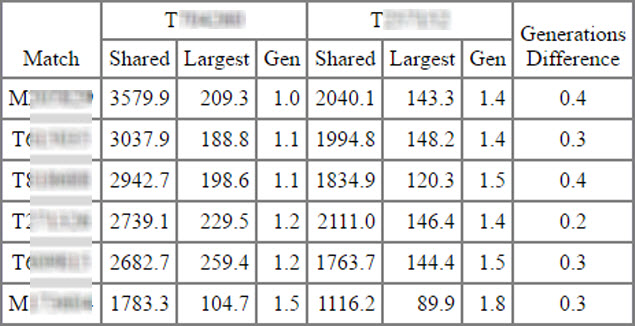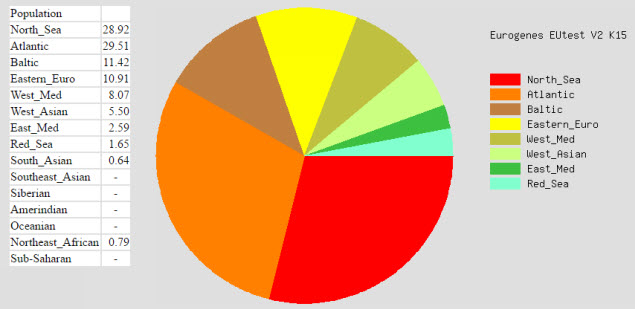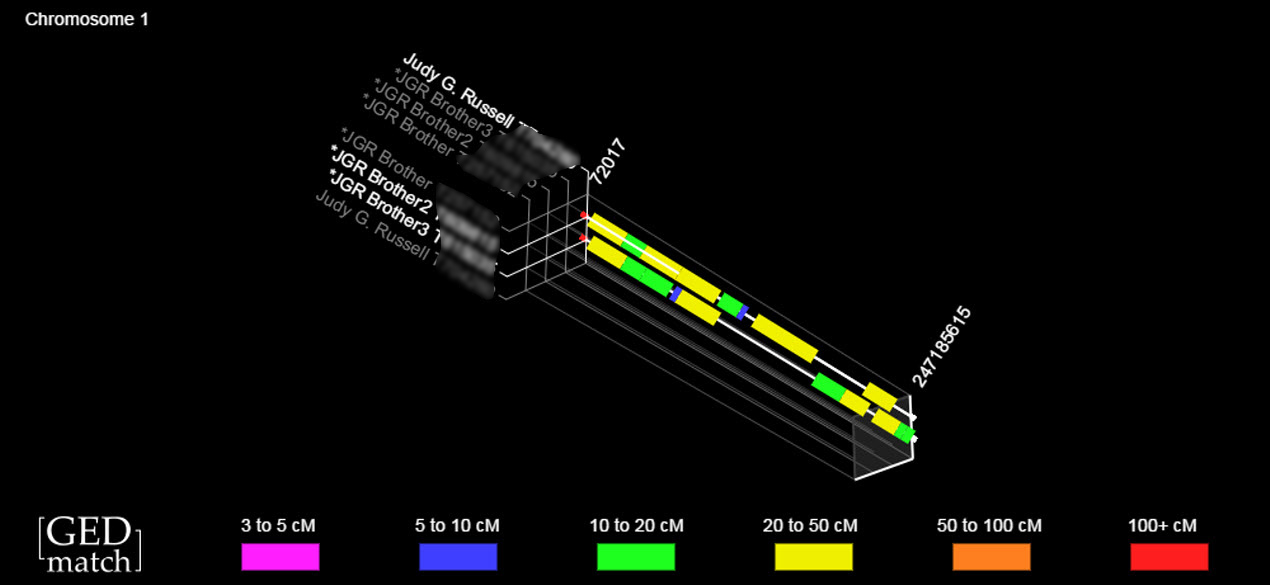Great DNA utility website
NOTE: This blog’s recommendation of GEDmatch has been withdrawn due to privacy issues. See “Withdrawing a recommendation,” The Legal Genealogist (https://www.legalgenealogist.com/blog : posted 15 May 2019).
Even now, five years after The Legal Genealogist was launched and began discussing using DNA for genealogical research, it still is occasionally surprising to find that not everyone is ready, willing and able to test with every DNA company on the planet, or at least in the United States.
Just because doing a full round of tests with Family Tree DNA, 23andMe, AncestryDNA, My Heritage DNA, LivingDNA, National Geographic’s Geno 2.0 project and others will set you back several hundred dollars is no reason not to let loose your inner DNA geek, is it?
Oh. Yeah. Right.
There is that little problem of the mortgage and the kids’ school clothes and that doctor bill and…
Sigh… Don’t you just hate it when real life interferes with what you want to do?
But there is a way to fill in some of the gaps, at least for autosomal DNA tests! Let me introduce you to — or remind you about — a wonderful website: GEDmatch.com, with tools for genetic genealogy research that carry a whopping big price tag of exactly zero. That’s not a typo. The site is free, though some tools do carry a price tag and donations are gratefully accepted. (Note: Anybody who uses the site really should kick in — it isn’t cheap to provide the kind of computing power Gedmatch provides.)
The brainchild of Curtis Rogers and John Olson (a distant DNA cousin of mine), Gedmatch offers a range of utilities that make it a little easier to extract every bit of potentially useful information out of your autosomal test results. Autosomal DNA testing, remember, is the kind that works across gender lines so you don’t have to find a direct male line from father to son to son (YDNA or Y-DNA1) or a direct female line from mother to daughter to daughter (mitochondrial DNA or mtDNA2). It particularly helps you identify cousins with whom you can share research.3
To use the site at all, you need to register:

That means providing your name and email and choosing password. You will need to use your real name to register, though you can choose an alias for your data. The site explains:
We ask that you provide real names for registration and data upload. In addition, you have the option of providing an alias for either login or data. If an alias has been provided, it will be displayed in place of the real name. If your DNA is linked to your genealogy, and only one or the other uses an alias, it may be possible for users to see the real name in the linked data.
In today’s world, there are real dangers of identity theft, credit fraud, etc. We try to strike a balance between these realities and the need to share information with other users. In the end, if you require absolute privacy and security, we must ask that you do not upload your data to GEDmatch. If you already have it here, please delete it.4
To use the site to full advantage, you need to download your raw autosomal DNA test results and match lists from your testing company and then upload them to Gedmatch. Many companies now make raw data available, and directions for downloading and uploading are on the Gedmatch site.5 And you can upload a GEDCOM with your family tree to see if you can identify common lines, using technology to help with traditional paper-trail genealogy too.
Again, although you do have to provide your email address and the exact name you used with your testing company, you don’t have to use your name publicly. You can be John’s Mom, or CountryCuzzin, if you prefer. You don’t have to make any of your information public if you’d rather not, although the utility of the website is limited if you don’t.
Once you’ve uploaded all the files, you’re ready to start playing with the utilities.
First, you can compare your results with the results of all other Gedmatch users who’ve made their results public — no matter what company they’ve tested with:
The results can be sorted by the total amount of DNA you have in common with others, measured in units called centimorgans or cM,6 by the longest segment you share, by the number of generations you’re likely distant from your matches and more. Email addresses of your matches may be listed, but can’t be copied-and-pasted to protect them from harvesting by spammers.
You can choose to see information about selected matches in a chromosome browser. Here’s what my results look like against my three brothers (two full siblings and a paternal half-sibling) on Chromosome 1:
There’s even a cool 3-D display of the matching segments if you want to see it that way:
And there are several matrix displays available that will display your selected matches not only as they match you but as they match each other, including a very useful option for displaying estimated distance to the most recent common ancestor.
There’s a genetic distance calculator, a relationship calculator, the ability to triangulate on match results to see how you and your match relate to others, a tool for checking to see if your parents are related to each other, and more.
One of my favorite tools is a quick and easy tool labeled “People who match both kits, or 1 of 2 kits.” I use it to see others that I have in common with a match, and it quickly produces a chart showing information as to how each of us compares to each common match. The chart does have email addresses, deleted here in this example showing matches I share with my paternal half-brother.

There’s more than enough here to satisfy your inner DNA geek. You can phase data — if you and one or both of your parents have tested, this utility will help identify what portions of your DNA came from which parent. You can match your DNA against archaic DNA (see the explanation here).
And there are many different options for displaying admixture (ethnicity or deep ancestry) data — and each of them has options galore. Here’s my admixture under just one of those options:

If that’s not enough, there are what are called Tier 1 tools, which are not free — they cost $10 a month. They include an updated comparison system, matching segment search capability, tools to help identify triangulation groups and more.
For anybody interested in learning more about DNA, or even just playing around with results, this is one cool set of utilities. For anyone who tested at AncestryDNA, which lacks this sort of analytical tool, it’s an essential set of utilities.
So take a look at Gedmatch and what it can offer.
Highly recommended.
SOURCES
- ISOGG Wiki (http://www.isogg.org/wiki), “Y chromosome DNA test,” rev. 4 Dec 2016. ↩
- ISOGG Wiki (http://www.isogg.org/wiki), “Mitochondrial DNA,” rev. 31 Jan 2017. ↩
- ISOGG Wiki (http://www.isogg.org/wiki), “Autosomal DNA,” rev. 31 Jan 2017. ↩
- “GEDmatch.Com Policy Statement,” GEDmatch.com (http://www.gedmatch.com/ : accessed 25 Mar 2017). ↩
- Ibid., “GEDmatch raw DNA upload utility.” ↩
- ISOGG Wiki (http://www.isogg.org/wiki), “Centimorgan,” rev. 13 Mar 2017. ↩






i have had excellent success with Gedmatch, even using it to correctly guess the last name of an adoptee’s birth father, based on people who matched us both. I love that matches two people feature, which can really narrow down which line you are looking at when a new DNA match appears. I urge all my matches to use it!
yup. My Go To matching site. Like FTDNA, too, but it seems like I get more responses from people I contact at GEDMatch.
Since December, I’ve identified a second cousin, discovered her biological father and found a half-sibling who was her brother. The half-sibling brother just discovered he has a son who he knew nothing about. All with Gedmatch. Amazing tool.
Keep in mind that people on GEDmatch tend to be interested in genealogy. Many who do not, just bought kits for the ethnicity or other gimmickery.
I was back playing with it today and though there can be steep learning curve for interpretation of results and the differences each of the tools comes up with, it is a fantastical tool. As long as you recognize that many of the results go back thousands of years to neolithic populations etc. Those Caucuses and Anatolian results come from ancient movements of peoples into central Europe etc. I still get some perplexing results since I know my ancestry back many generations.
“To use the site to full advantage, you need to download your raw autosomal DNA test results and match lists from your testing company and then upload them to Gedmatch.” Full advantage??
Are you saying that you can get some partial benefit without uploadimd your raw data? If so, I must have missed that.
You could use someone else’s kit number; you could just upload a GEDCOM file. There are ways to make less than full personal use of the site.
Thank you for this post. I am just beginning my DNA journey and appreciate those who are way ahead of me sharing what they have learned.
This is a truly wonderful and unique site.I love it.It gives so much more than Ancestry and it is free. The guys at Gedmatch are always willing to help.You really must down and upload your RawDNA. It is easy. I thought that I would not be able to do it.At 73 I don’t always get it.So glad that I tried and succeeded.So much I would have missed out on. Best Wishes to all Gina U K
am having trouble sending 23 and me info to gedmatch
You can contact Gedmatch by using the link at the bottom of any page. Just click on the site name.
I’m having difficulty uploading yDNA STR (or SNP) results from FTDNA to GEDMatch. It says the file is too small. Does it not handle STR or SNP data?
You can’t transfer YDNA results into GEDMatch: it works for autosomal testing only.
I uploaded both Family Tree Family finder and mt DNA to gedmatch.
Did I mess any of my raw data up, or is it just duplicated? I
was assigned a kit number for both. Do I need to do anything?
Do you really mean mtDNA? That shouldn’t have worked, since GedMatch is only for autosomal DNA.
I uploaded to Gedmatch both my wife’s & my profiles. I’ve since learned that an individual (or more) is using the database to solve police crimes. I know that the privacy contracts for other DNA collection sites have made this off-limits. I’m seriously considering pulling my data from the site. Is this a real concern, or am I being paranoid? I know to some people, the question seems as if I have something to hide, but I don’t. I am concerned about my privacy. I share my DNA for genealogical purposes only, especially in the off chance an adoptee can find their family. I don’t care about authorities closing cases, cold or otherwise.
Only you can decide whether the risk of having your DNA used this way is worth it to you. To that end, you might want to read my posts “The bull in the DNA china shop” and “The price of sharing.”